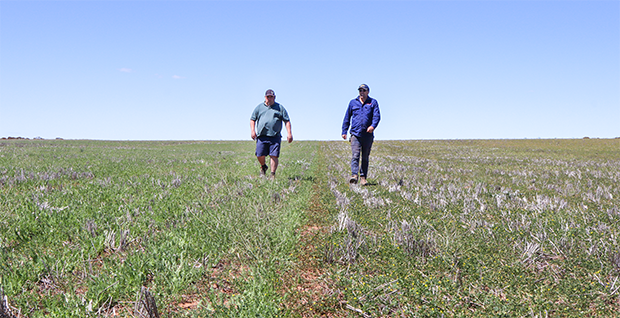Southern: Committed growers support hardy pasture legume revolution
Southern: Committed growers support hardy pasture legume revolution
Date: 04 Jul 2022

Identification and development of novel hard-seeded pasture legumes teamed with cost-reducing management practices and dedicated extension efforts are heralding a revolutionary change for growers in South Australia and Victoria’s low to medium-rainfall regions.
The Dryland Legume Pasture Systems (DLPS) project worked for five years (2017–22) in four states to improve management and better quantify benefits for animal and crop production within mixed-farming systems.
The project was a co-investment from the Grains Research and Development Corporation (GRDC), the Australian Government Department of Agriculture, Water and the Environment (DAWE) as part of its Rural R&D for Profit program, Meat and Livestock Australia (MLA) and Australian Wool Innovation (AWI).
It supported legume pasture research at the South Australian Research and Development Institute (SARDI), CSIRO, Murdoch University, the Western Australian Department of Primary Industries and Regional Development (DPIRD), and New South Wales Department of Primary Industries (DPI).
In addition to ongoing work on medics, the DLPS focused on aerial-seeded legume species, which can be harvested on-farm. Work from WA suggested a small amount of seed can be multiplied on-farm at minimal cost, especially when combined with twin or summer sowing. These hard-seeded varieties provide ‘legumes on demand’ that regenerate from the seedbank in the soil after one or more years of cropping.
Lasting benefits of these novel species include increased agility in the choice of crop or pasture production and the production of a highly nutritious forage for livestock, with the potential to reduce methane and greenhouse gas emissions for meat and wool production systems.
These legumes also increase nitrogen fixation in the farming system, reduce the need for fertiliser inputs and boost grain yield and protein contents in following crops.
The southern pasture development component was led by seasoned rhizobiologist Ross Ballard and pasture researcher David Peck from SARDI. Bonnie Flohr (CSIRO) and Michael Moodie (Frontier Farming Systems) focused on measuring the benefits pastures provide.
Nineteen demonstration trials were established in SA and Victoria over the course of the DLPS.
Michael Moodie oversaw several of the field trials on growers’ properties in the south, including large strip trials at Scott Anderson’s property at Ouyen in Victoria.
“The DLPS has been great for identifying knowledge we have generated and the new legume varieties we have released or are soon to be released, including Fran2o serradella, a new yellow serradella, a Trigonella balansae, a new bladder clover and SeraphA medic.
“The power of the DLPS has been bringing together a diverse, multidisciplinary team and co-learning with growers. The project has provided great opportunities for researchers to learn how new knowledge from complementary disciplines may be applied to existing problems and lead to the development of innovative solutions.
“To build on the success of the DLPS, Professor Howieson says, it is important for soil types and farming systems that could benefit from the adoption of the new pasture legume species,” Mr Moodie says.

“In this region legumes such as pulses and vetch have become common place on the better soil types, however, growers are still looking for a legume with improved production on more challenging soils such as deep sands. It is a significant change for growers to consider new species that may have different roles in their farming systems.”
In this respect Mr Moodie says there may be instances where pasture legumes may be more robust than pulses. For example, serradella could have a niche as an alternative to lupins in the deep sands of the region, especially as serradella share the same rhizobium group as lupins.
“Using serradella together with the twin sowing technique may offer operational ease for growers and reduce erosion by providing soil cover over summer and avoiding another sowing operation to establish pasture in the next season.
“But this is a big change in farming systems thinking and growers require ongoing support to make it happen.”
Nationally, forty-eight demonstration sites were established across the program. While COVID-19 restrictions curtailed the number of field site visits and workshops delivered in some states, more than 9,000 adviser/grower interactions occurred. About 500 growers were estimated to have sown new pasture areas as a result of the work.
Seraph strand medic showed good powdery mildew resistance and tolerance to sulfonyl urea herbicide residues, and it widely adapted to alkaline clay-loam soils across SA and Victoria. It was released to growers in 2021, and more than 20,000 hectares are expected to be produced in 2020.
Now, early adopters in each region have become champions for the new legumes, sharing their experiences and management practices with other growers. A common lesson is that when growers manage their pastures with similar attention to detail as their crops, their whole farming system benefits with increases in livestock and crop profits.
An independent national survey of 400 mixed-farming growers in the low-rainfall zone was commissioned by CSIRO on behalf of the program. Results are still being collated but will quantify current levels of adoption (including DLPS impacts), as well as understand barriers and future drivers of adoption to direct further pasture development.
For more information, read the full article on GRDC’s Groundcover online, or view the Groundcover supplement Dryland pasture legumes, a new era for mixed farms.
Contact Details
Interviews
Stephen Loss, GRDC Senior Regional Manager South
stephen.loss@grdc.com.au
0408 412 453
Contact
Danielle Gault, GRDC Communications Manager
danielle.gault@grdc.com.au
0448 766 881
GRDC Project Code: UMU1805-001RMX,
